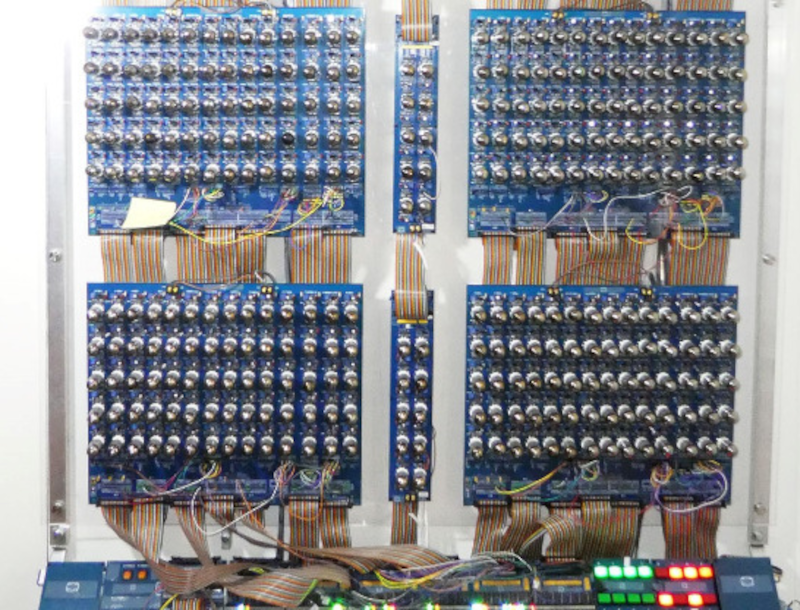While it’s currently the start of summer in the Northern Hemisphere, it will inevitably get cold again. If you’re looking for a unique way of heating your workshop this year, you could do worse than build an 8-bit computer with a bunch of 6N3P vacuum tubes. While there are some technical details, you might find it a challenging build. But it is still an impressive sight, and it took 18 months to build a prototype and the final version. You can find the technical details if you want to try your hand. Oh, did we mention it takes about 200 amps? One of the prototype computers plays Pong on a decidedly low-tech display, which you can see below.
The architecture has 8 data bits and 12 address bits. It only provides six instructions, but that keeps the tube count manageable. Each tube has two triodes in one envelope and form a NOR gate which is sufficient to build everything else you need. In addition to tubes, there are reed relays and some NVRAM, a modern conceit.
Operating instructions are to turn it on and wait for the 560 tubes to warm up. Then, to quote the designer, “… I check the fire extinguisher is full, and run the code.” We wonder if one of the six instructions is halt and catch fire. Another quote from the builder is: “It has been a ridiculous amount of soldering and a fantastic amount of fun.” We can imagine.
If the computer seems familiar, we covered the first and second prototypes named ENA and Fred. We’ve also seen tube-base single-board computers.

















In the broadcast biz, I’m told, FRED was the name hung on the least reliable piece of equipment in the studio, standing for Effing Ridiculous Electronic Device.
Usagi Electric did it better IMO (if you haven’t seen his vacuum tube computer project, go look it up)
His doesn’t play pong (nor I’d it remotely close to done just barely functioning)
” (nor I’d it remotely close to done just barely functioning)”
English speak not?? :)
I think it’s breakout and not pong.
It is pong alright. In Breakout you bounce the ball with a paddle to break blocks. Pong is much simpler where you simply bounce the ball between two paddles.
Would this be considered a hybrid? Seeing lot’s of diodes mixed in with those tubes
That was common in historical vacuum tube computers, even from the early crystal diode days.
Glossy blue soldermask and NVRAM are unforgivable, ofc, though.
200 amps at what voltage? 6.3 volts for the filaments?
An excellent and astounding build. I had trouble seeing the resemblance to pong but the trophy smash at the end was classic. Now all that is needed is a small block of platinum of 5 to 6 pounds to build a duo-dynetic field core to construct a “mnemonic memory circuit using stone knives and bear skins”.
200A at 12V is a single HP server PSU module – with tiny fans screaming. But powering those 6V tubes in pairs in series means 100A and a lot less noise. They are about $25 now and another $20 for PCB with the edge connector and PC type power cable sockets.
While being an impressive build, it’s also a waste of tubes. The circuitry looks like a “backport” of DTL, with every other triode just acting as a buffer. I’m too lazy now to go into further detail, but I guess that by using computer design principles from the 1950s, tube count could be reduced by >50%.
It would be nice to have some sort of reference, or even an acronym or two, so I can look up what these 1950s design principles to reduce the tube count might be.
A lot of literature can be found on archive.org, search for combinations of “computer”, “logic”, “pulse”, “digital”, “circuits”, etc. and look for publications issued no later than the 1960s. Maybe start with “Theory and design of digital machines” by Bartee/Lebow/Reed and “Understanding digital computers” by Siegel. Books on this subject usually do not contain dimensioning of circuit elements, but bitsavers.org has enough documentation on actual implementations.
Some of the things that could be done are:
* Diode gates can be casacded to several levels, providing AND/OR combinations.
* Cathode followers are only needed to drive many inputs or transmission lines, often the anode output of the first triode is strong enough. Level shifting can be done with resistor networks.
* Triodes can be paralleled or stacked just like FETs in integrated circuits. Of course this needs higher supply voltages.
* A heptode like the EH90/6CS6 makes a fast NAND gate, both control grids have nearly identical characteristics.
* Diodes can be used as switches with proper biasing. Often called “transmission gate” or “pulse gate”.
* Using AC coupling (pulses) instead of levels can eliminate drift and biasing problems.
But how’s it sound if you plug a bass into it? /s
Fishy